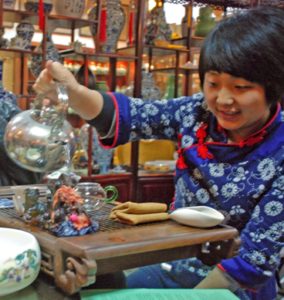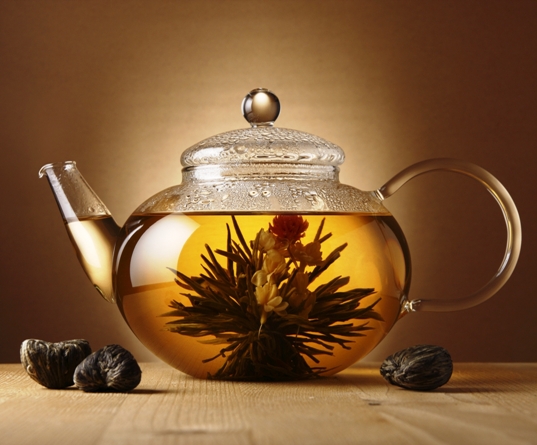We drink tea to relax, to socialize, to mark important events in our lives, to apologize, for an energy booster, for our health, and to honor a valued guest. The Doctor even requires it to repair his malfunctioning TARDIS. Tea is so ubiquitous a drink in our world that to NOT offer a cup in some places is considered a social faux pas. It is common, and yet ceremonies abound celebrating its properties and use. It is Asian in origin, and yet it has been adopted and enjoyed by most of the world. Above all, for our purposes, the history of tea is entwined with the history of the Silk Road. (For post about the Burmese origins of tea – click here.)
On our recent trip to China, we had the opportunity to enjoy a tea ceremony and sample a wide variety of different teas. More of a learning experience than a formal ceremony, our tea guide explained the importance of fragrance, the many and varied ways that teas are processed and the qualities that Chinese medicine ascribes to different teas. Then we learned how the first few quick steepings of tea were poured out over the cups and pot to wash the tea and clean and warm the cups. Different teas are best steeped in waters of different temperature and green tea needs only steep for 1-2 minutes while other teas require longer time to coax the full flavor out of them. Some teas like high quality oolongs cane be steeped multiple times and some feel that their flavor improves with age. Some of the teas sampled were:
Yang Tea
This tea comes from a mountain that is rich in selenium – a powerful antioxidant – and in Traditional Chinese Medicine (TCM) is believed to be good for the mind and liver function and for preventing diseases of the spleen and kidneys. This tea contains 20 times more selenium than other teas.
Pu’er Tea
This tea has a distinctively earthy flavor which gets better and smoother as it ages. This tea is thought to detoxify the liver and relieving constipation. It is also said to be good for losing weight because of the microorganisms that help ferment the tea also help to speed digestion.
Ku Ding Tea
This tea is brewed with only one leaf per cup and still imparts one of the strongest flavors of all teas. It is believed to lower blood pressure and reduce congestion in the blood vessels thereby reducing the risk of stroke and heart disease. It is also thought to be beneficial in preventing or mitigating diabetes.
 Jasmine Tea
Jasmine Tea
This is a mixture of high quality green tea and jasmine flowers. It can relieve headaches and improve digestion and even improve complexions when the strained tea leaves are used as a facial mask.
Gingseng Oolong Tea
This tea is mixed with powdered ginseng root and is said to enhance immunity and increase vitality. Some also drink it for the sweet taste it leaves in the mouth and throat that is similar to licorice.
Lychee Black Tea
Powdered lychee fruits from China’s tropical areas are mixed with tea to make a sweet and flavorful tea that is said to be good for the skin.
Dragon Well Tea
This tea tastes like roasted hazelnuts and is enjoyed all over China for its memory enhancing properties and the ability for it to lift one’s spirits. It is said to detoxify the blood, increase metabolism, and reduce the harm caused by free-radicals.
Da Hong Pao
Also called rock tea because of how it is planted in and near rocks to enhance the growth of the plant and the flavor of the tea. It has the aroma and flavor of smoked wood which is used during tea processing. It is said to relieve abdominal distention and quenches thirst.
Chrysanthemum Tea
This flower tea is good for the throat and is said to lower the body’s inner heat and improving balance. It is believed to reduce oral cavities and gingivitis.
An Xi Ti Guan Yin Tea
This tea has the gentle fragrance of fresh orchids and green grass and is good for relaxation and increasing calm. It is rich in vitamins E and C and the is believed to improve vision, reduce body weight and promote longevity.
White Tea
Made from immature tea leaves picked just before the buds have fully opened, this tea takes its name from the silver fuzz covering the buds that turns white as it dries. High in antioxidants and immunity-boosting phytochemicals, this tea is an excellent adaptogen.
My favorite teas from a flavor point-of-view are Pu’er and Dragon Well tea, although the aroma of the floral teas and the sight of them opening in the water is really lovely. In general, there is a lot of beauty in tea. For me, that is part of the pleasure and part of the problem. I can’t bring myself to break up the compressed Pu’er bricks with pictures of horses and tigers to brew and instead have them hanging around the house from red knotted cords.
When the chrysanthemum blooms in the water, I don’t want to drink the tea to have it become a soggy sponge at the bottom of the glass – I want to appreciate the buoyant bloom forever. For millennia, chrysanthemums have been the last natural flowers to bloom each year in most of Eurasia before the chill of winter descends. At my age, it is no wonder I am hesitant for the flower to fade.
Of course, this reluctance to destroy beauty is but a limitation caused by my attachment to the object (beautiful tea bricks) and to the aesthetics of the beverage as a culinary creation. Haven’t you ever seen a dish presented so beautifully that you found it difficult to take that first bite? Drinking a cup of chrysanthemum tea is a bit like that for me. Well, if attachment is the problem, then more tea . . . I mean more Tao is the answer.
(Words by Laura Kelley. Photos of Chrysanthemum Tea in Bloom by © Artefy | Dreamstime.com; photo of Tea Ceremony – Xian by Laura Kelley; and the photo of the Chrysanthemum tea Pods by © Jasony01 | Dreamstime.com.)

